Ques.81. Kirchoff’s voltage law applies to the circuit with (SSC 2016, Set-2)
- Linear elements only
- Non-linear elements only
- Linear, non-linear, active and passive elements
- Linear, non-linear, active, passive time-variant as well as the time-invariant element
Answer.4. Linear, non-linear, active, passive time-variant as well as the time-invariant element Explanation:- Kirchhoff’s Voltage Law (KVL,) or Kirchhoff’s Loop Rule. This law is based on the conservation of energy and maybe stated as under: In any closed electrical circuit or loop, the algebraic sum of all the electromotive force (e.m.f s) and voltage drops in resistors is equal to zero, i.e., in any closed circuit or loop. The algebraic sum of e.m.f s + Algebraic sum of the voltage drops = 0 The validity of Kirchhoff’s voltage law can be easily established by referring to the loop ABCDA shown in Fig. If we start from any point (say point A) in this closed circuit and go back to this point (i.e., point A) after going around the circuit, then there is no increase or decrease in potential. This means that algebraic sum of the e.m.f.s of all the sources (here only one e.m.f. source is considered) met on the way plus the algebraic sum of the voltage drops in the resistances must be zero. Kirchhoff’s voltage law is based on the law of conservation of energy, i.e., the net change in the energy of a charge alter completing the closed path is zero. V1 + V2 − V = 0 or Kirchhoff’s voltage law is also called a loop rule. KVL and KCL and apply to any lumped electric circuit; it does not matter whether the circuit elements are linear, nonlinear, active, passive, time-varying, time-variant, etc. In other words, KVL and KCL are independent of the nature of the elements.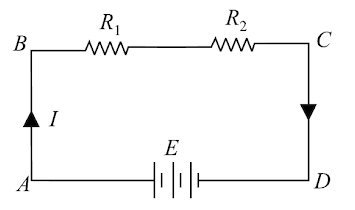
Ques.82. To neglect a voltage source, the terminals across the source are ____ (SSC 2016, Set-2)
- Open-circuited
- Short-circuited
- Replaced by some resistance
- Replaced by capacitance
Answer.2. Short-circuited Explanation:- An ideal voltage source does not have any internal resistance it means there is no resistance in series with the voltage source. So an ideal voltage source is having zero equivalent resistance. An ideal voltage source makes circuit short-circuited. Similarly, if we have a zero resistive path in parallel with an ideal current source, the parallel path makes the current source open-circuited. An ideal current source has the infinite internal impedance
Ques.83. The best indication about the state of charge on a lead-acid battery is given by (SSC 2016, Set-2)
- Specific gravity of the electrolyte
- Temperature of electrolyte
- Output voltage
- None of these
Answer.1. Specific gravity of the electrolyte Explanation:- The lead-acid battery is the oldest and most mature among the all-battery technologies. Because of their large applications, lead-acid batteries have the lowest cost of all-battery technologies. This battery operates at ambient temperature and has an aqueous electrolyte. Even though the lead-acid battery is relatively inexpensive, it is very heavy, with limited usable energy by weight (specific energy). The state of charge of a lead-acid battery can be determined by the specific gravity of the electrolyte (its weight compared to water). The specific gravity can be measured directly with a hydrometer or determined by the stabilized voltage. A hydrometer is a bulb-type syringe that will extract electrolyte from the cell. A glass float in the hydrometer barrel is calibrated to read in terms of specific gravity. A common range of specific gravity used on these floats is 1.160-1.325. The lower the float sinks in the electrolyte, the lower its specific gravity is. Measuring the specific gravity of a battery’s electrolyte with a hydrometer is the most accurate way to test the state of charge. This is true because the concentration of sulfuric acid changes as the battery is charged or discharged, and the change in concentration corresponds with a change in electrolyte density. Specific gravity is a measurement of the density of a liquid. The specific gravity of 1.260 in a lead-acid battery means that the battery is fully charged. As the battery is discharged, the specific gravity of the electrolyte falls to 1.120 for a state of charge of 0 percent.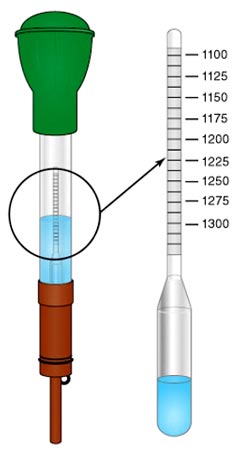
Ques.84. If a capacitor is charged by a square wave current source, the voltage across the capacitor is ____ (SSC 2016, Set-2)
- Square wave
- Triangular wave
- Step function
- Zero
Answer.2. Triangular wave Explanation:- The simplest way to generate a triangular wave is to apply a square wave to an RC network, . This is an integrator circuit, and the output is taken from across the capacitor. When the square wave switches positive, the capacitor charges through the resistor to the square wave voltage. As we know that, the charge curve of a capacitor is not really a straight line, but it closely approximates a straight line for a portion of the curve. When the square wave switches to zero, the capacitor discharges through the resistor, producing a negative-going voltage. The resulting waveform approximates a triangular wave, but it is not linear enough for many applications. In many applications, the triangular wave must be linear. Greater linearity can be achieved by making the RC time constant very long, compared to the period of the square wave. This causes the capacitor to charge and discharge on only a short portion of the charge-discharge curve. or The voltage across the capacitor is (VC) = 1/C ∫i(t) dt Here the current source i(t) is the square wave which is a step function. Therefore, the voltage developed across the capacitor will triangular wave since the integration of the square wave is the triangular wave.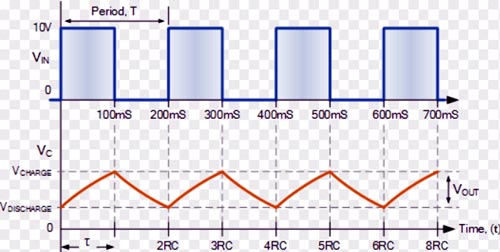
Ques.86. Absorbed moisture contents affect the dielectric strength __ (SSC 2016, Set-2)
- Directly
- Indirectly
- Does not affect
- None of these
Answer.2. Indirectly Explanation:- Materials that restrict or prohibit the flow of sound or heat or electricity through them are called insulators or insulating materials. They also avoid the accumulation of heat by proper distribution. The requirement of good insulating materials can be classified as electrical, mechanical, thermal and chemical. Electrically the insulating material should have high resistivity to reduce the Leakage current and high dielectric strength to enable it to withstand higher voltage without being punctured or broken down. Further, the insulator should have a small dielectric loss. Dielectric properties:- The following important properties of insulation are taken into consideration in electrical insulating materials. (a) High Resistivity:- Electrical conductivity is the capacity of a material to conduct the electric current. Resistivity is the reciprocal of conductivity and is commonly measured as Insulation resistance. Thus a good insulator is that which possesses low conductivity or high resistivity. (b) High Dielectric strength:- The Dielectric strength of an insulating material determines its ability to resist puncture or breakdown by electric potentials. Hence the limiting intensity by electric field above which the insulators get punctured or ruptured is called the dielectric strength of the dielectric and is commonly expressed in volts per mm of the thickness of the material or volts per centimeter. The dielectric strength of a material can also be defined as the electrical field strength, that must be applied to cause a disruptive effect or discharge (arc or spark) or accumulate current through the body of the material. The dielectric strength is affected by the number of factors such as (a) Dielectric strength decreases as the thickness of the material increases (b) Dielectric strength decreases as the time of the application of electric current increases (c) Dielectric strength decreases as the frequency of the applied electric field is increased (d) Dielectric strength decreases in the presence of humidity. (e) Dielectric strength decreases with an increase in temperature in case of air as an insulator. (c) Low Dielectric loss:- These are generally caused due to the absorption of electrical energy and also by the leakage of current through the insulating material. The absorption of electrical energy. under an alternating electric field gives rise to the dissipation of the electrical energy in the insulating material, while leakage takes place as a result of conduction. The conduction is appreciable, however, only at high temperatures, otherwise, it is negligible. A good and ideal dielectric is that which does not absorb electrical energy and the charge of the capacitor is completely recovered when the electrical field is removed. A dielectric material, however, always causes some electrical energy loss, which is measured by the phase difference between the phase angle and 90 angles of an ideal capacitor. A perfect insulator is that which has the phase angle of 90 and loss angle zero.
Ques.87. Which of the following theorems enables the number of voltage (or current) source to be combined directly into a single voltage (or current) source? (SSC 2016, Set-2)
- Compensation theorem
- Reciprocity theorem
- Superposition theorem
- Millman’s theorem
Answer.4. Millman’s theorem Explanation:- It is possible to combine the number of voltage sources or current sources into a single equivalent voltage or current source, using Millman’s theorem. Millman’s theorem is used to simplify circuits having several parallel voltage sources as shown in the figure. The statement of the Millman’s theorem is, If n voltage sources V1, V2 ,……………………….Vn having internal Resistance (or series Resistance) R1, R2 ,……………………….Rnrespectively are in parallel, then these sources may be replaced by a single voltage source of voltage Veq having a series impedance Req, Where Veq and Req is given as

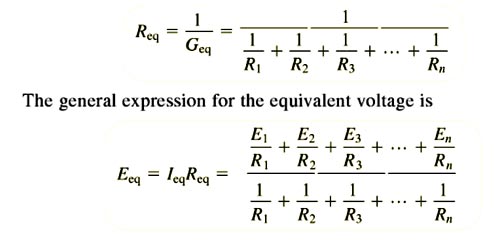
Ques.88. The internal voltage drop of a voltage source ____ (SSC 2016, Set-2)
- Is the highest when no load is applied
- Does not influence the terminal voltage
- Depends upon the internal resistance of the source
- Decreases with increase load current
Answer.3. Depends upon the internal resistance of the source Explanation:- The load current supplied by any voltage source, whether it be a cell or battery, a generator, or a transformer, also passes through the voltage source itself. This is because the voltage source is part of the complete circuit around which the load current flows. In other words, the ‘inside’ of the voltage source is in series with its external load. So what exactly do we mean by the ‘inside’ of a voltage source? Well, in the case of a generator, for example, the load current must also pass through the windings (coils) in which the voltage is generated by the rotating machine. In the case of a generator, the internal resistance is the resistance of the windings within which the voltage is generated. In the case of a cell or battery, the internal resistance is made up of the combined effect of two components: the first is due to the resistivity of the internal conducting parts (the electrodes and any metallic connections), and the second, called ‘ionic resistance’, is due to the electrochemical opposition within the electrolyte. The first increases as the cell’s electrodes dissolve (in the case of nonchargeable cells) because their effective cross-sectional area reduces; the second increases as the cell de-energizes. The internal resistance of a fully energized, healthy cell is typically expressed in milliohms but, as the cell deteriorates, its internal resistance may rise markedly. A cell’s internal resistance will also vary according to its state of charge. The internal resistance of a generator’s windings is also low, but will increase somewhat when the windings are hot (see the chapter on the effect of temperature on resistance), whenever the machine is running for prolonged periods. The effect of the voltage source’s internal resistance is to cause an internal voltage drop (IR;) to occur within the voltage source itself. The direction of this voltage drop is such that it always acts to oppose the electromotive force of the voltage source and to reduce the value of the terminal voltage applied to the load. The larger the load current, the larger the corresponding internal voltage drop, and the loiter the terminal voltage applied to the load. The voltage appearing across the load is called the terminal voltage (U), and is the difference between the voltage source’s electromotive force (E) and its internal voltage drop (lR), that is: U= E − IR For any given load resistance, the greater the internal resistance, the lower the voltage source’s terminal voltage. For any given internal resistance, the lower the load resistance, the taller the voltage source’s terminal voltage. If there is no load connected to the voltage source, then no-load current will flow, and there will be no internal voltage drop. the voltage appearing across the voltage source’s terminals under this condition is called its open-circuit voltage or no-load voltage which exactly equals the electromotive force (e.m.f.) of that source. A voltage source’s open-circuit, or no-load, voltage corresponds to its electromotive force.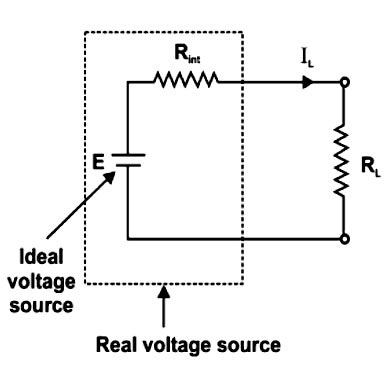
Ques.89. The transient currents are due to ______. (SSC 2016, Set-2)
- Voltage applied to circuit
- Resistance of the circuit
- Impedance of the circuit
- Change in stored energy in inductors and capacitance
Answer.4. Change in stored energy in inductors and capacitance Explanation:- Transient is any sudden change in the system caused by generator shifting, faults, outages, addition or removal of a heavy load or any switching operation in the system. Transients are non-steady-state time variations of voltages and currents which occur as a result of switching circuit elements and (or) changing interconnections of electric circuits. The transients occur because of the presence of energy storage elements (i.e., inductors and capacitors). As we know that the potential difference across a capacitor cannot change instantaneously and that the current through an inductor cannot change suddenly. If therefore, when a circuit containing capacitance or/and inductance is operating in the steady-state and conditions change for some reason, requiring the current and voltage values to change, there will be a finite period of time during which these changes take place. This period is called a period of transient operation. Two obvious examples of transient operation are (1) when a circuit containing capacitance or inductance is initially switched on and (2) when such a circuit, having been operating in the steady-state for some time, is suddenly switched off. These transient conditions are associated with the changes in the energy stored in the capacitor or the inductor, and circuits containing either of these elements are called single energy circuits. Circuits containing both of these elements are called double energy circuits. Because there is no energy stored in purely resistive circuits, currents and voltages in such circuits are able to change without periods of transient operation (i.e. instantaneously).
Ques.90. In the electrical circuit diagram as shown below the value of current in 3Ω resistor is (SSC 2016, Set-2)
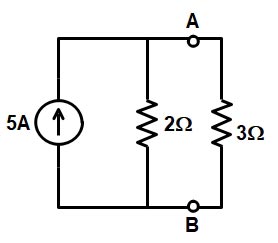
- 2 Ampere
- 0.2 Ampere
- 1.6 Ampere
- 1 Ampere
Answer.1. 2 Ampere Explanation:- Applying current divider rule in the following circuit I3ohm = ITotal R1 /(R1 + R2 ) I3ohm = 5 × 2/( 2 + 3) I3ohm = 2 A
